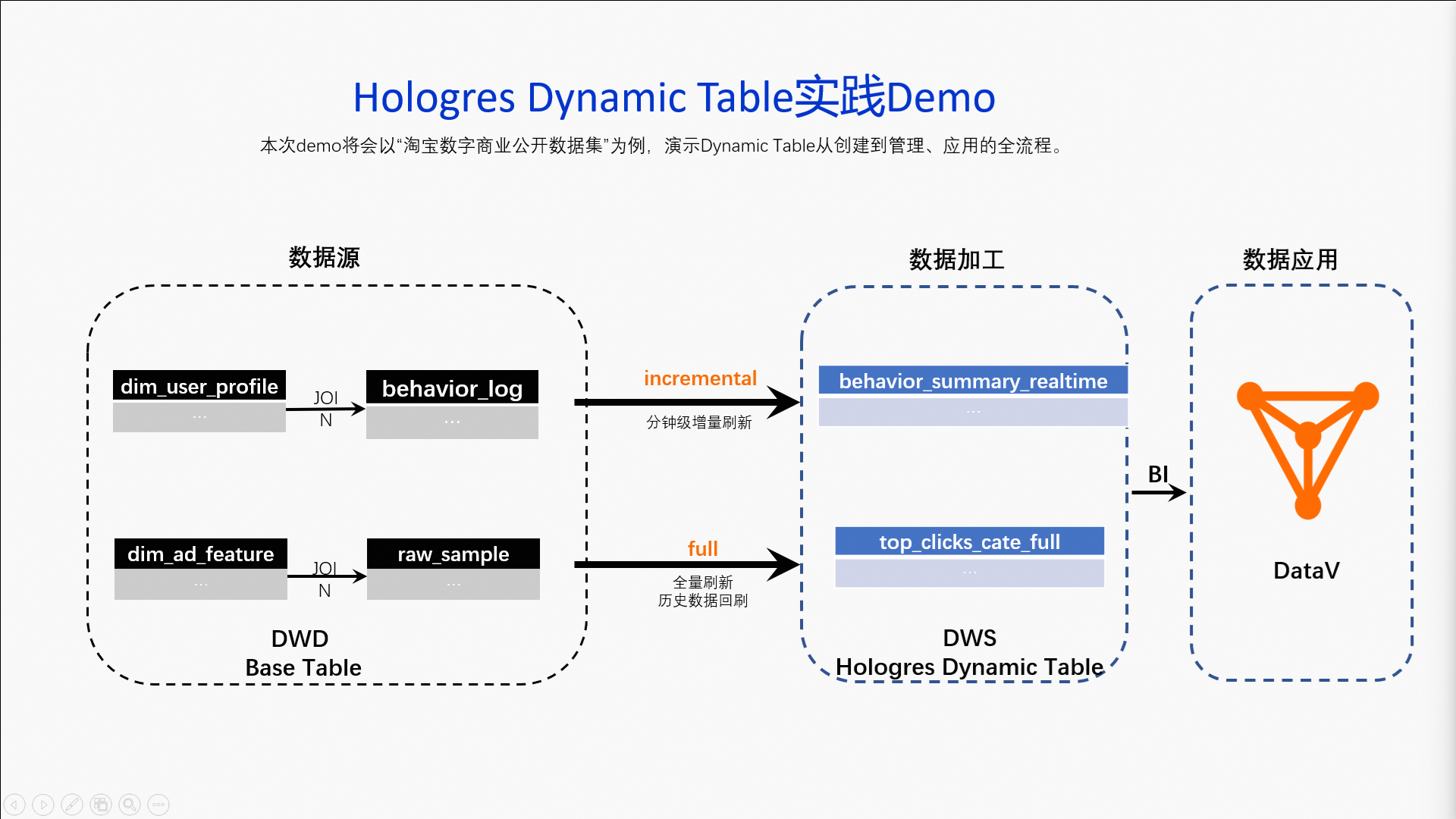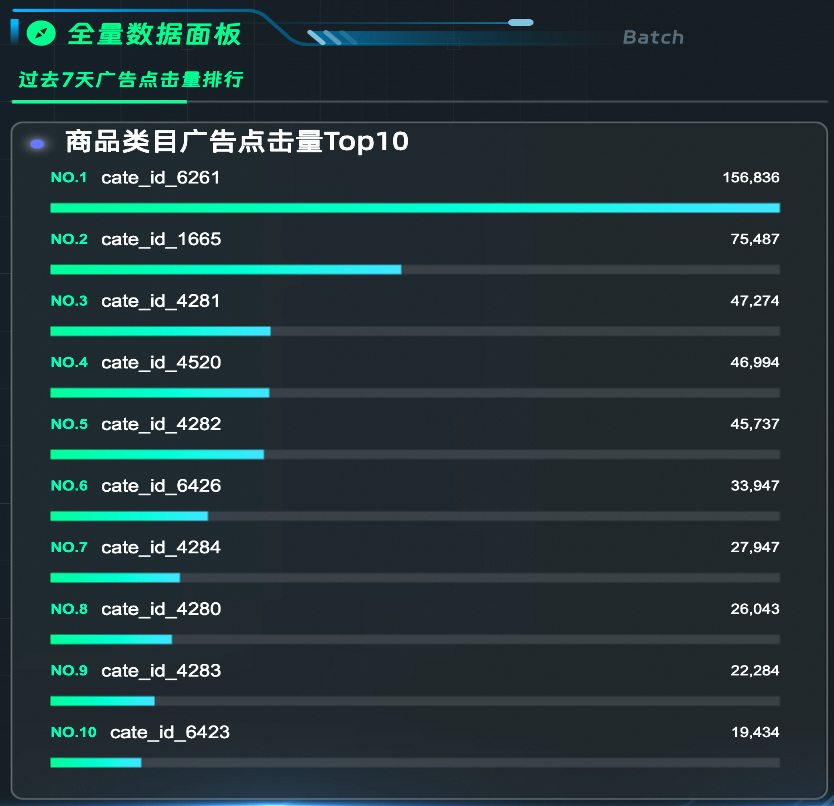基于Hologres Dynamic Table搭建多模式計算數(shù)據(jù)大屏
本文將為您介紹通過Hologres Dynamic Table的增量刷新和全量刷新兩種模式,滿足多種業(yè)務(wù)場景的數(shù)據(jù)分析需求,并通過Hologres對接BI分析工具(本文以DataV為例),實現(xiàn)海量數(shù)據(jù)的實時與離線分析,助力業(yè)務(wù)快速進行數(shù)據(jù)分析和數(shù)據(jù)探查。
背景信息
傳統(tǒng)數(shù)倉架構(gòu)
傳統(tǒng)中要實現(xiàn)離線、近實時或?qū)崟r的查詢需求,需要引用多套系統(tǒng)來實現(xiàn)。傳統(tǒng)數(shù)倉Lambda架構(gòu)中存在一些問題,包括架構(gòu)復雜、組件繁多、運維難度高及成本大。由于計算引擎的不一致性,數(shù)據(jù)加工標準難以統(tǒng)一,同時造成了數(shù)據(jù)冗余和同步難題,增加了資源消耗。此外,缺乏有效的數(shù)據(jù)倉庫分層策略,導致查詢延遲問題突出,操作不便,開發(fā)效率低下。

基于Hologres Dynamic Table的多模式統(tǒng)一計算架構(gòu)
Hologres從3.0版本開始支持Dynamic Table,提供全量刷新和增量刷新兩種刷新模式,支持數(shù)據(jù)自動刷新與流動刷新,通過多模式的統(tǒng)一計算,能有效地解決實時數(shù)倉分層、流批一體等強需求,同時也能實現(xiàn)性能、成本、時效性等的完美平衡。

場景介紹
Hologres Dynamic Table增量刷新和全量刷新模式介紹如下:
增量刷新:場景1:累計增量成交分析。
數(shù)據(jù)鏈路如下。
數(shù)據(jù)源:本次示例中的數(shù)據(jù)來源為MaxCompute中的公開數(shù)據(jù)集,需要將數(shù)據(jù)寫入到Hologres內(nèi)部表,成為Dynamic Table的Base表。
數(shù)據(jù)加工:在Hologres中將Base表的數(shù)據(jù),加工成兩張Dynamic Table,分別配置增量刷新和全量刷新,形成DWS,滿足業(yè)務(wù)的不同查詢時效性。
數(shù)據(jù)應(yīng)用:本次示例使用DataV展示Dynamic Table中數(shù)據(jù)的變化情況。

準備工作
環(huán)境準備
準備Hologres環(huán)境。
您需開通Hologres,創(chuàng)建并連接Hologres數(shù)據(jù)庫,后續(xù)在Hologres數(shù)據(jù)庫中執(zhí)行命令讀取數(shù)據(jù)。
說明您也可以申請Hologres的免費資源包,免費試用體驗本教程的核心步驟。Hologres提供的免費資源包介紹及申請引導,詳情請參見新用戶免費試用。
建議開通Hologres Serverless資源,將刷新任務(wù)提交到Serverless集群執(zhí)行,可以有效地隔離刷新任務(wù)之間的相互影響,詳情請參見Serverless Computing概述。
準備DataWorks開發(fā)環(huán)境。
本次示例使用DataWorks進行Dynamic Table的創(chuàng)建和SQL開發(fā),需要使用DataWorks新版數(shù)據(jù)開發(fā),確保已開啟參加數(shù)據(jù)開發(fā)(Data Studio)(新版)公測參數(shù)。具體操作,請參見創(chuàng)建工作空間并綁定計算資源。
您需要將上述Hologres數(shù)據(jù)源綁定至DataWorks開發(fā)環(huán)境。
(可選)準備大屏搭建產(chǎn)品:本文以DataV為例。
本文以DataV為例,為您展示大屏搭建后的效果。
數(shù)據(jù)準備(準備Hologres Base表)
您需要創(chuàng)建如下表并將MaxCompute的公開數(shù)據(jù)集(數(shù)字商業(yè)數(shù)據(jù)集)其數(shù)據(jù)導入到Hologres內(nèi)部表中,再創(chuàng)建Dynamic Table進行數(shù)據(jù)加工。
public.dim_ad_featurepublic.behavior_logpublic.raw_samplepublic.dim_user_profile
內(nèi)部表的建表DDL和數(shù)據(jù)導入SQL如下。
--創(chuàng)建外表
CREATE SCHEMA foreign_holo;
IMPORT FOREIGN SCHEMA "BIGDATA_PUBLIC_DATASET#commerce" LIMIT to
(adv_raw_sample,adv_ad_feature,user_profile,behavior_log)
FROM server odps_server INTO foreign_holo options(if_table_exist 'error');
--創(chuàng)建廣告基本信息維表
DROP TABLE IF EXISTS public.dim_ad_feature;
BEGIN;
CREATE TABLE public.dim_ad_feature (
adgroup_id bigint NOT NULL,
cate_id bigint,
campaign_id bigint,
customer_id bigint,
brand bigint,
price double precision
,PRIMARY KEY (adgroup_id)
) WITH (
orientation = 'column',
storage_format = 'orc',
distribution_key = 'adgroup_id'
);
END;
--導入維表數(shù)據(jù)
INSERT INTO dim_ad_feature SELECT
try_cast(adgroup_id as bigint) as adgroup_id,
try_cast(cate_id as bigint) as cate_id,
try_cast(campaign_id as bigint) as campaign_id,
try_cast(customer_id as bigint) as customer_id,
try_cast(brand as bigint) as brand,
price::double precision
FROM foreign_holo.adv_ad_feature;
--創(chuàng)建用戶行為表
DROP TABLE IF EXISTS public.behavior_log;
BEGIN;
CREATE TABLE public.behavior_log (
user_id bigint,
ds text,
"time" text,
behavior_type text,
cate bigint,
brand bigint
) WITH (
orientation = 'column',
storage_format = 'orc',
binlog_level = 'replica',
binlog_ttl = '2592000',
bitmap_columns = 'ds,"time",behavior_type',
dictionary_encoding_columns = 'ds:auto,"time":auto,behavior_type:auto',
distribution_key = 'cate'
);
END;
--導入數(shù)據(jù)
INSERT INTO behavior_log SELECT
"user"::bigint,
date(to_timestamp(time_stamp::bigint)),
to_timestamp(time_stamp::bigint),
btag::text,
cate::bigint,
brand::bigint
FROM foreign_holo.behavior_log
WHERE date(to_timestamp(time_stamp::bigint))='2017-05-13' ;
--創(chuàng)建廣告明細表
DROP TABLE IF EXISTS public.raw_sample;
BEGIN;
CREATE TABLE public.raw_sample (
user_id bigint,
adgroup_id bigint,
ds text,
"time" text,
pid text,
noclk integer,
clk integer
) WITH (
orientation = 'column',
storage_format = 'orc',
binlog_level = 'replica',
binlog_ttl = '2592000',
bitmap_columns = 'ds,"time",pid',
dictionary_encoding_columns = 'ds:auto,"time":auto,pid:auto',
distribution_key = 'user_id'
);
END;
--導入數(shù)據(jù)
INSERT INTO raw_sample SELECT
user_id::bigint,
adgroup_id::bigint,
date(to_timestamp(time_stamp::bigint)),
to_timestamp(time_stamp::bigint),
pid::text,
noclk::integer,
clk::integer
FROM foreign_holo.adv_raw_sample;
--創(chuàng)建用戶基礎(chǔ)信息維表
DROP TABLE IF EXISTS public.dim_user_profile;
BEGIN;
CREATE TABLE public.dim_user_profile (
user_id bigint NOT NULL,
cms_seg_id bigint,
cms_group_id bigint,
final_gender_code integer,
age_level integer,
pvalue_level integer,
shopping_level integer,
occupation integer,
new_user_class_level integer
,PRIMARY KEY (user_id)
) WITH (
orientation = 'column',
storage_format = 'orc',
distribution_key = 'user_id'
);
END;
--導入數(shù)據(jù)
INSERT INTO dim_user_profile SELECT
try_cast(userid as bigint),
try_cast(cms_segid as bigint),
try_cast(cms_group_id as bigint),
try_cast(final_gender_code as integer),
try_cast(age_level as integer),
try_cast(pvalue_level as integer),
try_cast(shopping_level as integer),
try_cast(occupation as integer),
try_cast(new_user_class_level as integer)
FROM foreign_holo.user_profile WHERE userid != 'userid';場景1:累計增量成交分析
在實際應(yīng)用中,某些業(yè)務(wù)場景并不需要實時分析,例如:業(yè)務(wù)需要累積分析每小時的行為數(shù)據(jù)、成交數(shù)據(jù)等,允許數(shù)據(jù)有一定的延遲(近實時分析場景)。可以通過Dynamic Table的增量刷新,對新增數(shù)據(jù)的進行計算,減少數(shù)據(jù)計算量,同時也能提升數(shù)據(jù)加工的時效性,滿足近實時數(shù)據(jù)分析需求。
創(chuàng)建Dynamic Table
使用DataWorks數(shù)據(jù)開發(fā)平臺創(chuàng)建Dynamic Table,只需填寫表名并添加查詢SQL語句即可。若您使用Hologres控制臺,完整創(chuàng)建SQL詳情請參見增量刷新Dynamic Table。
登錄DataWorks控制臺,選擇。
在數(shù)據(jù)開發(fā)(新版)頁面,選擇目標工作空間,單擊進入數(shù)據(jù)開發(fā)(新版)。
單擊左側(cè)
 ,在數(shù)據(jù)目錄頁面,選擇Hologres。
,在數(shù)據(jù)目錄頁面,選擇Hologres。單擊添加實例。
在DataWorks數(shù)據(jù)源頁簽,單擊已綁定目標數(shù)據(jù)源操作列的添加為數(shù)據(jù)目錄。
選擇。
填寫表名:例如
commerce_behavior_summary_incrmental。若您自定義其他表名,下方查詢SQL一并進行修改。在SQL開發(fā)界面填寫SQL如下。
SELECT behavior_log.ds, substring(behavior_log.time, 12, 2) as hour, behavior_log.behavior_type, COUNT(*) AS total_behavior_count, COUNT(DISTINCT behavior_log.user_id) AS uv_count FROM behavior_log JOIN dim_user_profile FOR SYSTEM_TIME AS OF PROCTIME() AS user_profile ON behavior_log.user_id = user_profile.user_id WHERE user_profile.shopping_level > 1 GROUP BY behavior_log.ds, hour, behavior_log.behavior_type;單擊預編譯,對語法正確性進行校驗。
右側(cè)選擇刷新策略,完成參數(shù)配置。
參數(shù)名稱
說明
刷新模式
選擇增量刷新(Incremental)。
數(shù)據(jù)刷新開始時間
選擇建表成功立即開始。
數(shù)據(jù)刷新周期間隔
1分鐘。
Hologres 計算資源
選擇Serverless 資源。
Hologres 計算資源規(guī)格
32Core。

填寫完成后,提交發(fā)布,發(fā)布成功后代表已經(jīng)創(chuàng)建成功,增量刷新任務(wù)將會根據(jù)設(shè)置的刷新間隔周期性刷新Dynamic Table,實現(xiàn)數(shù)據(jù)的增量計算。
查詢數(shù)據(jù)
增量Dynamic Table的刷新任務(wù)執(zhí)行后,可以開始查詢數(shù)據(jù)的增量變化,示例查詢SQL如下。
每小時瀏覽量。
--每小時瀏覽量 SELECT hour, total_behavior_count, uv_count FROM commerce_behavior_summary_incrmental WHERE ds = '2017-05-13' AND behavior_type = 'pv' ORDER BY hour;每小時購買量。
--每小時購買量 SELECT hour, total_behavior_count, uv_count FROM commerce_behavior_summary_incrmental WHERE ds = '2017-05-13' AND behavior_type = 'buy' ORDER BY hour;
增量大屏展示
當增量刷新任務(wù)啟動成功后,可以直接使用Dynamic Table對接應(yīng)用查詢數(shù)據(jù),本實踐直接對接DataV大屏實時展示數(shù)據(jù)。操作步驟如下。
創(chuàng)建Hologres數(shù)據(jù)源(可選)。
將數(shù)據(jù)所在的Hologres實例和數(shù)據(jù)庫創(chuàng)建為DataV的數(shù)據(jù)源,詳情請參見DataV。
創(chuàng)建可視化應(yīng)用。
登錄DataV控制臺。
在工作臺頁面,單擊創(chuàng)建PC端看板。
選擇已有模板或自定義模板,完成可視化數(shù)據(jù)展示。
示例展示每小時累計行為數(shù)據(jù),使用DataV的柱狀圖可以直觀地展示增量數(shù)據(jù)的變化。

場景2:歷史廣告數(shù)據(jù)分析與數(shù)據(jù)回刷
業(yè)務(wù)通常會有歷史數(shù)據(jù)關(guān)聯(lián)分析的場景,可以通過Dynamic Table的全量刷新(full)模式支持這種場景。批量刷新將會一次性刷新全量的數(shù)據(jù),通過Dynamic Table就能完成歷史數(shù)據(jù)的加工與計算,然后快速分析。本次實踐通過全量刷新模式來計算過去7天廣告點擊排行榜Top10,通過DataWorks頁面可視化創(chuàng)建Dynamic Table全量刷新模式。
創(chuàng)建Dynamic Table
使用DataWorks數(shù)據(jù)開發(fā)平臺創(chuàng)建Dynamic Table,只需填寫表名并添加查詢SQL語句即可。若您使用Hologres控制臺,完整SQL詳情請參見全量刷新Dynamic Table。
登錄DataWorks控制臺,選擇。
選擇目標工作空間,單擊左側(cè)
 圖標,進入數(shù)據(jù)目錄頁面。
圖標,進入數(shù)據(jù)目錄頁面。選擇HOLOGRES,單擊選擇
 圖標添加實例。
圖標添加實例。在DataWorks數(shù)據(jù)源頁簽中單擊已綁定的目標數(shù)據(jù)源操作列的添加為數(shù)據(jù)目錄,完成綁定操作。
選擇。
填寫表名:例如
commerce_top_clicks_cate_full。若您自定義其他表名,下方查詢SQL一并進行修改。在SQL開發(fā)界面填寫SQL如下。
SELECT raw_sample.ds, ad_feature.cate_id, COUNT(*) AS total_browses, COUNT(DISTINCT raw_sample.user_id) AS total_unique_visitors, SUM( CASE WHEN raw_sample.clk = '1' THEN 1 ELSE 0 END ) AS total_clicks FROM raw_sample raw_sample JOIN dim_ad_feature FOR SYSTEM_TIME AS OF PROCTIME() AS ad_feature ON raw_sample.adgroup_id = ad_feature.adgroup_id GROUP BY raw_sample.ds, ad_feature.cate_id;單擊預編譯,對語法正確性進行校驗。
右側(cè)選擇刷新策略,完成參數(shù)配置。
參數(shù)名稱
說明
刷新模式
選擇全量刷新(Full)。
數(shù)據(jù)刷新開始時間
選擇建表成功立即開始。
數(shù)據(jù)刷新周期間隔
24小時。
Hologres 計算資源
選擇Serverless 資源。
Hologres 計算資源規(guī)格
32Core。

填寫完成后,提交發(fā)布,發(fā)布成功后代表已經(jīng)創(chuàng)建成功,全量刷新任務(wù)將會根據(jù)設(shè)置的刷新間隔周期性刷新Dynamic Table,實現(xiàn)數(shù)據(jù)的全量計算。
查詢數(shù)據(jù)
全量刷新的Dynamic Table的刷新任務(wù)執(zhí)行完成后,代表歷史數(shù)據(jù)全量計算完成,可以直接查詢Dynamic Table進行數(shù)據(jù)分析。示例SQL如下。
--過去7天廣告點擊排行
SELECT 'cate_id_' || cate_id, sum(total_clicks) AS sum_total_clicks FROM commerce_top_clicks_cate_full WHERE ds <= '2017-05-13' AND ds >= TO_CHAR(ds::date - INTERVAL '6 days', 'YYYY-MM-DD') GROUP BY cate_id ORDER BY sum_total_clicks DESC limit 10;全量大屏展示
可以直接將Dynamic Table對接DataV大屏展示數(shù)據(jù)。本實踐已經(jīng)提前準備好了DataV大屏,并連接好了數(shù)據(jù)源和配置大屏,能直接展示數(shù)據(jù)。

歷史數(shù)據(jù)回刷
在實際場景中,歷史數(shù)據(jù)可能會變化,為了保證數(shù)據(jù)口徑的一致性,需要對歷史數(shù)據(jù)刷新。可以通過Dynamic Table全量刷新的模式來完成歷史數(shù)據(jù)的回刷,減少任務(wù)的維護,提升回刷的效率。本實踐演示回刷場景,在DataWorks新建Hologres SQL節(jié)點,執(zhí)行如下SQL。
模擬上游維表更新。
模擬業(yè)務(wù)中上游維表更新的場景,在DataWorks界面執(zhí)行如下SQL對維表數(shù)據(jù)進行更新。
查詢出數(shù)據(jù)。
SELECT * FROM raw_sample JOIN dim_ad_feature FOR SYSTEM_TIME AS OF PROCTIME () AS ad_feature ON raw_sample.adgroup_id = ad_feature.adgroup_id WHERE ad_feature.cate_id = '6261';模擬維表更新,將維表按照主鍵更新。
INSERT INTO dim_ad_feature (adgroup_id,cate_id) VALUES ('451376','888888'),('650847','000000') ON CONFLICT (adgroup_id) DO UPDATE SET cate_id = EXCLUDED.cate_id WHERE dim_ad_feature.cate_id= '6261';
回刷Dynamic Table。
當維表更新完成后,需要對Dynamic Table執(zhí)行一次刷新,匹配新的維表數(shù)據(jù),從而保證數(shù)據(jù)口徑的一致性。直接對Dynamic Table執(zhí)行Refresh,即可完成回刷。
REFRESH TABLE commerce_top_clicks_cate_full;
回刷完成后,查看DataV大屏,全量數(shù)據(jù)面板中數(shù)據(jù)已經(jīng)更新。

附錄:Dynamic Table
增量刷新Dynamic Table
--累計增量成交分析,增量刷新
DROP TABLE IF EXISTS commerce_behavior_summary_incrmental;
CREATE DYNAMIC TABLE commerce_behavior_summary_incrmental WITH (
auto_refresh_enable='true',
refresh_mode = incremental,
incremental_auto_refresh_schd_start_time='immediate',
incremental_auto_refresh_interval = '1 minutes',
incremental_guc_hg_computing_resource = 'serverless',
incremental_guc_hg_experimental_serverless_computing_required_cores='32'
)
AS
SELECT
behavior_log.ds,
substring(behavior_log.time, 12, 2) as hour,
behavior_log.behavior_type,
COUNT(*) AS total_behavior_count,
COUNT(DISTINCT behavior_log.user_id) AS uv_count
FROM
behavior_log
JOIN dim_user_profile FOR SYSTEM_TIME AS OF PROCTIME() AS user_profile ON behavior_log.user_id = user_profile.user_id
WHERE
user_profile.shopping_level > 1
GROUP BY
behavior_log.ds,
hour,
behavior_log.behavior_type;全量刷新Dynamic Table
--歷史廣告數(shù)據(jù)分析,全量刷新
DROP TABLE IF EXISTS commerce_top_clicks_cate_full;
CREATE DYNAMIC TABLE commerce_top_clicks_cate_full WITH (
auto_refresh_enable='true',
refresh_mode = full,
full_auto_refresh_schd_start_time='immediate',
full_auto_refresh_interval = '24 hours',
full_guc_hg_computing_resource = 'serverless'
)
AS
SELECT
raw_sample.ds,
ad_feature.cate_id,
COUNT(*) AS total_browses,
COUNT(DISTINCT raw_sample.user_id) AS total_unique_visitors,
SUM(
CASE WHEN raw_sample.clk = '1' THEN 1 ELSE 0 END
) AS total_clicks
FROM
raw_sample
JOIN dim_ad_feature FOR SYSTEM_TIME AS OF PROCTIME() AS ad_feature ON raw_sample.adgroup_id = ad_feature.adgroup_id
GROUP BY
raw_sample.ds,
ad_feature.cate_id;